I like to pretend that I’ve remained somewhat psychically unscathed by the pandemic, through a combination of self-awareness, fortitude, repression, and a twice-daily dose of a non-benzodiazepine anti-anxiolytic medication. I have become militant about certain habits, despite being a creature not given to routines. I eat my vegetables. I shower. I have forced myself to tolerate being alone with my thoughts all day, and have forced myself to not be alone when opportunities have safely arisen. I don’t sleep in very often anymore. I mourn, and trek onward.
Regrettably, I have also harbored deep resentment bordering on hostility toward people who seem to be more vulnerable to outward-facing anxiety than I am. People who still are washing their groceries, and who don’t want to go outside without yelling at joggers. Those who boast about not missing the biomes of strangers, and who — like all of us in a fucking crisis — are missing the forest for the trees, and thus would rather tend their own gardens than the overgrown, thorny capitalist jungle of our country’s pandemic response.
In my defense, I think some of my ire is founded. People who have been working with the public this whole time (like the other half of my household) have been treated alternately like lepers or martyrs by the at-homes, while the lepers’ daily concerns and wellbeing don’t seem to mirror the frenetic, virtuous anti-COVID posting of other assholes sitting around online all day at their home office jobs like I do. And while I regret admitting weakness to the moral heroes that irritate me, much of it is my own projection, too. I’ve gotten to stay safe at home, and our families and friends generally haven’t fallen seriously ill. I feel immense guilt about the invisible and exploited people who have kept things running this whole time and died as their only reward, while I get to be safely angry about our individual choices alone being unable to remake our broken system.
The exception to my unsustainable “no anxiety, no weakness” paradigm has become my houseplants and pets. In the worst of it this winter, when Johnathan was working 6 days a week delivering Christmas presents to rich assholes and I was crying into various spreadsheets, he would come home from work and I would give him the Daily Bulletin. The calathea lost three leaves and is crispy on the edges, and I think it needs filtered water. Something is wrong with the arrowhead plant, maybe it’s burning from too much sun. Rosie barfed twice and Buddy ate it both times! As I delivered this information to him in the urgent tones of someone who hasn’t seen another human being all day, I felt myself entering the ominous psychological state of Betty Draper, or, hell, Betty Friedan, with my single-minded intensity and almost-loathing for our home, my birdcage.
Despite this, isn’t there something wonderful about the little duties of caring for another living being? I imagine this is how parents must feel, to my lasting discomfort as a childless woman pushing toward the “geriatric” end of my fertility window; at least a kid eventually conveys more information than the blank and trusting stare of my dog, or the leaf with the tiny black spot. Mysteries of love. It’s no mistake that J and I only felt ready to start this little creative project after a year pregnant with pandemic-induced spiritual burdens. We had nothing to share with others for so long, like many, and now we are laden with appreciation for our little garden, and the need to extend it to others. It’s a gift and a privilege to be alive and safe, and to keep other things alive too. Sharing that gift feels inadequate, but urgent — placing a little ramekin of paté in front of my purring cat, or pruning a plant by our open window, or cooking a meal that we can bring out to the yard to our newly-vaccinated friends. Sometimes in the darkness of the forest, we have to look to the garden. See you next week, r
It’s funny that I spent last week singing the praises of spring vegetables, only to be treated to a second (or third) blast of winter and some late-April snow flurries. With that hopefully behind us for real this time, I wanted to throw together a quick pasta with some more of the green, snappy vegetables popping out of the cold ground and into our markets this month.
“Pasta Primavera” is something I never order at a restaurant, and I really only end up eating it when it’s the vegetarian option at a cousin’s wedding or something. Despite the name literally meaning “spring pasta,” often what you get is pasta with watery vegetables like zucchini and red bell pepper, or sitting in a cream sauce that drowns out any of the lightness we associate with spring. I wanted to get as far away from that as possible, and really lean into crunchy, bright flavors and textures. Sweet peas, crisp shoots of asparagus, and tender braised artichokes combine to capture everything we love about this season.
Some notes: You’ll want to look for English peas, which have to be shelled. Don’t bother with snow peas, but you could shell sugar snap peas and use those in a pinch. If you don’t want to mess around with fresh artichokes, at least get some of the frozen artichoke hearts from Trader Joe’s and save the brined ones for something else. You could use Parmigiano instead of pecorino, but the funkiness of sheep’s milk marries perfectly with the vegetables and really adds a lot to this dish. The red pepper flakes I’ve been using are Sichuan chili flakes, which are big on color and relatively low on heat. Pick rigatoni that are big enough to catch the vegetables inside. —j
PASTA PRIMAVERA
serves 2-3
10 ounces of dried rigatoni
1 cup of sliced asparagus (about half of a bunch)
½ cup of shelled English peas (from about ½ pound of peas in their pods)
2 small or medium artichokes
2 cloves of garlic
1 lemon
2 tablespoons of butter (cold)
¼ cup of chopped parsley
¼ cup of chopped basil
⅓ cup of grated pecorino cheese
q.b. extra virgin olive oil
Salt and pepper to taste
A few pinches of red pepper flakes
To prep:
Set two pots of salted water over high heat to boil.
Fill two deep bowls with cold water. Cut the lemon in half and squeeze the juice of one of the halves into one of the bowls. This bowl will be for the artichokes. Put a handful of ice cubes in the other bowl, which will be for the peas and asparagus.
Slice the cloves of garlic as thinly as possible.
Chop the basil and parsley, and grate the pecorino.
Shell the peas. The easiest way is to pinch the end of the pod that doesn’t have the stem attached, and pull out the tough, fibrous string like a zipper. Now the pod will easily pop open with a little pressure from your thumbnail. Place all the peas in a small bowl, and set aside.
Snap the woody ends off of the asparagus, and slice the stalks on the bias. Set them aside.
Break down the artichokes as shown in this video. Place them in the bowl of lemon water to keep them from turning brown.
Once your water is boiling, blanch the peas in one of the pots. Boil them until they all start to float and take on a vibrant green color, then transfer them to the bowl of ice water. Blanch the asparagus in the same pot with the same method, and place it in the ice water as well. Once the vegetables are cool to the touch, drain them and set them aside.
Remove the cleaned artichokes from the lemon water and chop them into small pieces.
To cook:
Place the rigatoni into the other pot of boiling water.
Set a large skillet over medium flame and coat the bottom with olive oil. When hot, add the sliced garlic with a big pinch of salt and pepper. When it starts to smell fragrant, add a pinch of red pepper flakes and the artichoke pieces. Sauté them for a couple of minutes, then add about a quarter cup of boiling pasta water to the pan and stir constantly. The artichokes are the only of our vegetables that will take much time to cook at all, and they’re also pretty resistant to overcooking, so don’t stress. Let them braise in the pan while you check the doneness of the pasta.
When the pasta is about 85% of the way done, add the blanched peas and asparagus to the skillet, and crank up the heat. Give everything a good shake, and add another quarter cup of pasta water. Check the pasta again, and when it’s just shy of being done, remove it from the water and add it to the skillet with the vegetables. Mix everything together well. Add the cold butter, the juice of the other half of the lemon, half the pecorino, and half the chopped herbs. Shake the pan vigorously until the fat in the butter and cheese and the starch from the pasta water combine to coat everything in a satiny emulsified sauce.
Divide the pasta and vegetables between two plates and top with the rest of the herbs, the rest of the pecorino, some freshly cracked pepper, and a light sprinkling of red pepper flakes. Enjoy with some wine in your backyard while your dog tries to dig under your fence to look for squirrels.
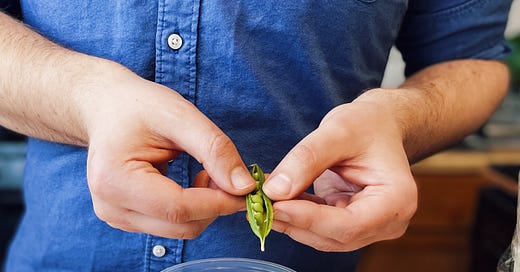



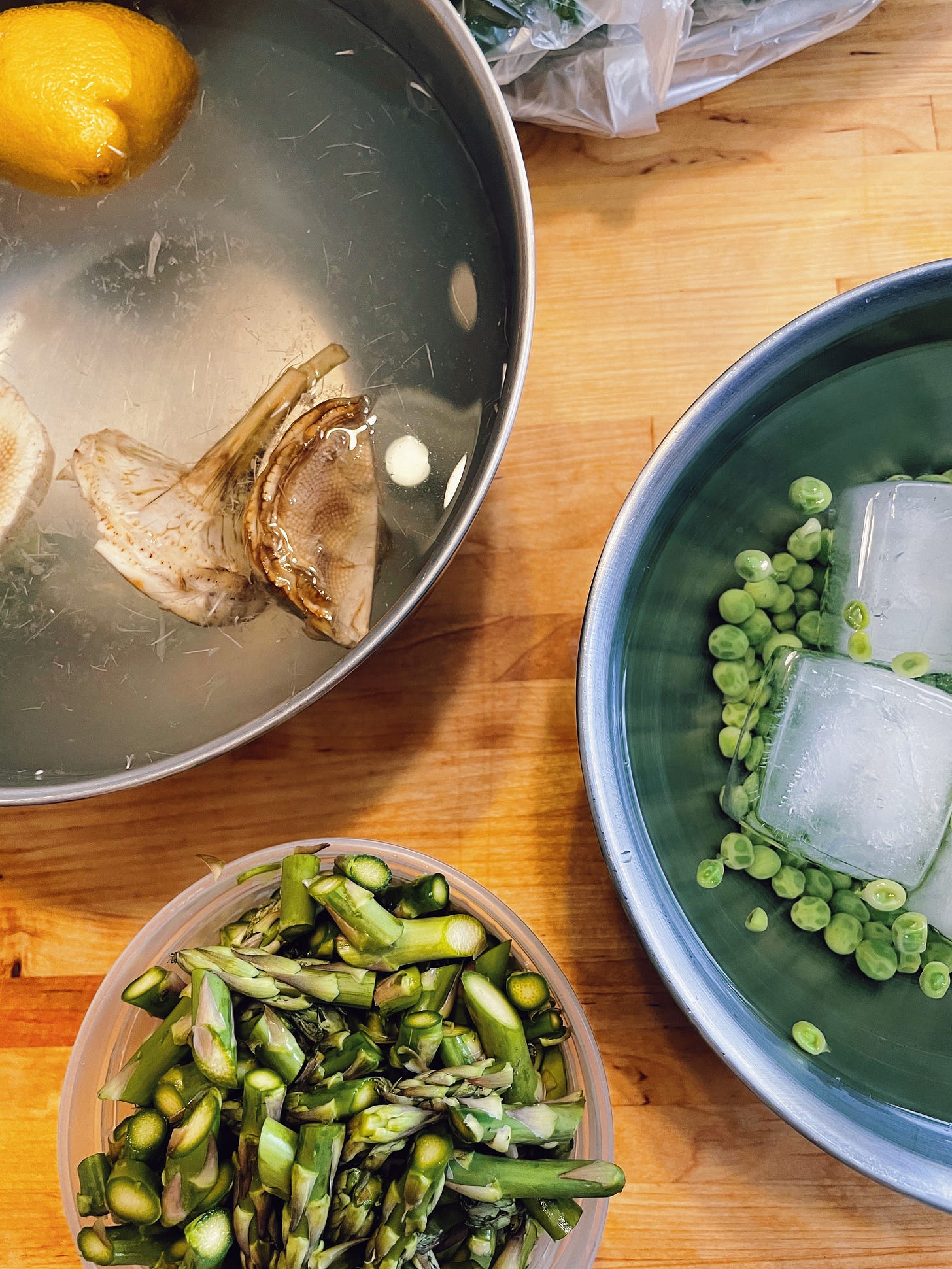
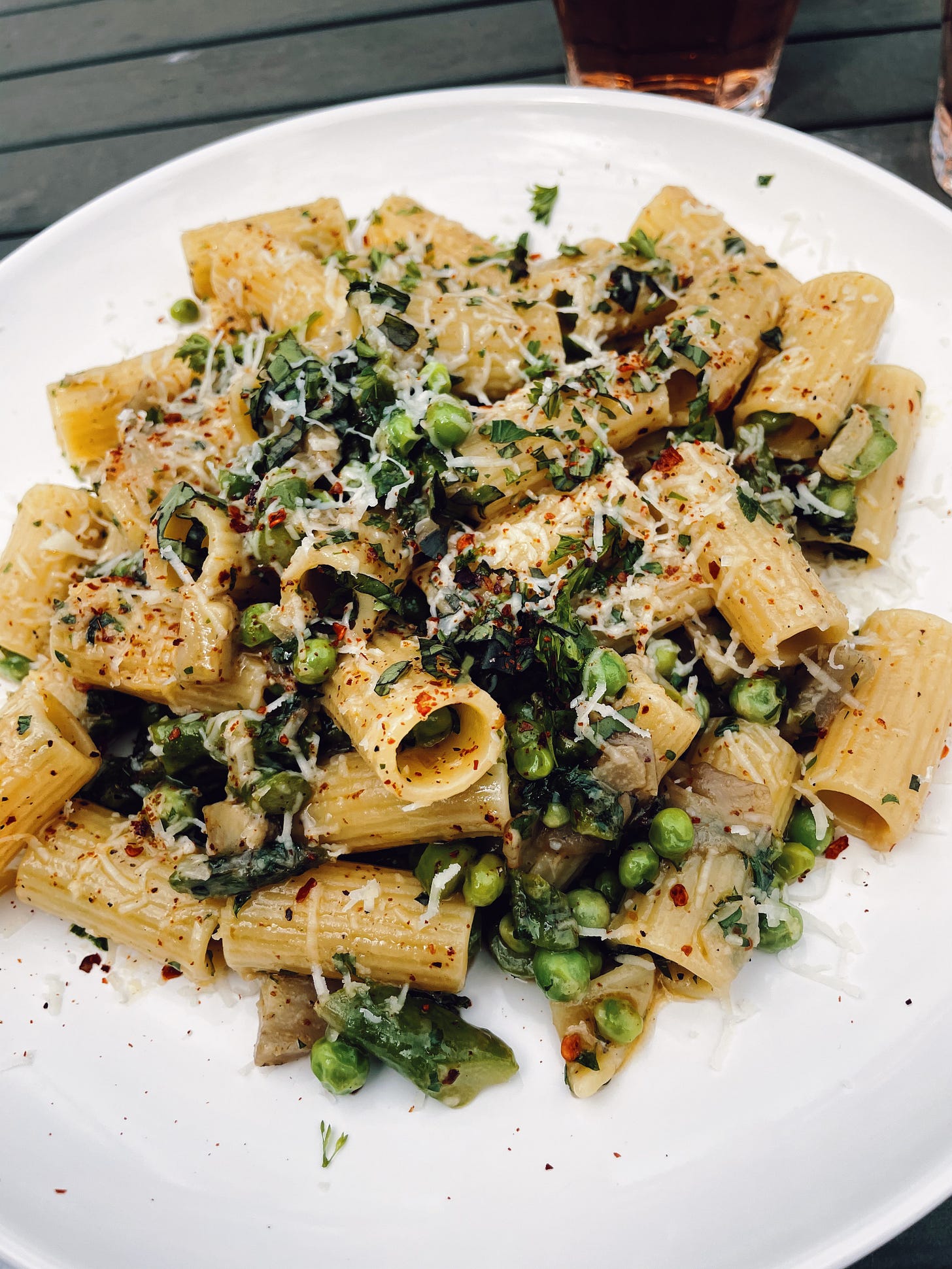
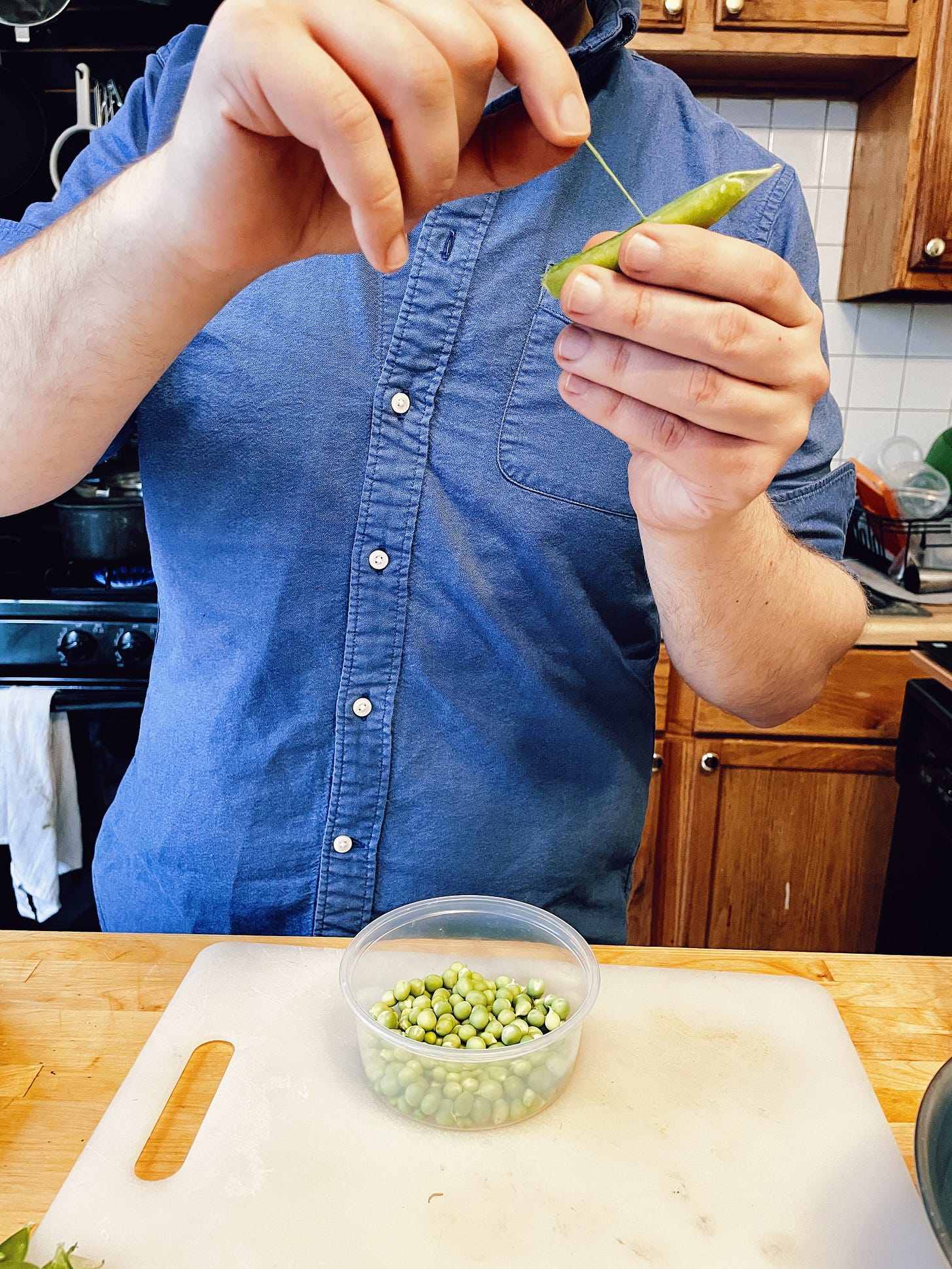
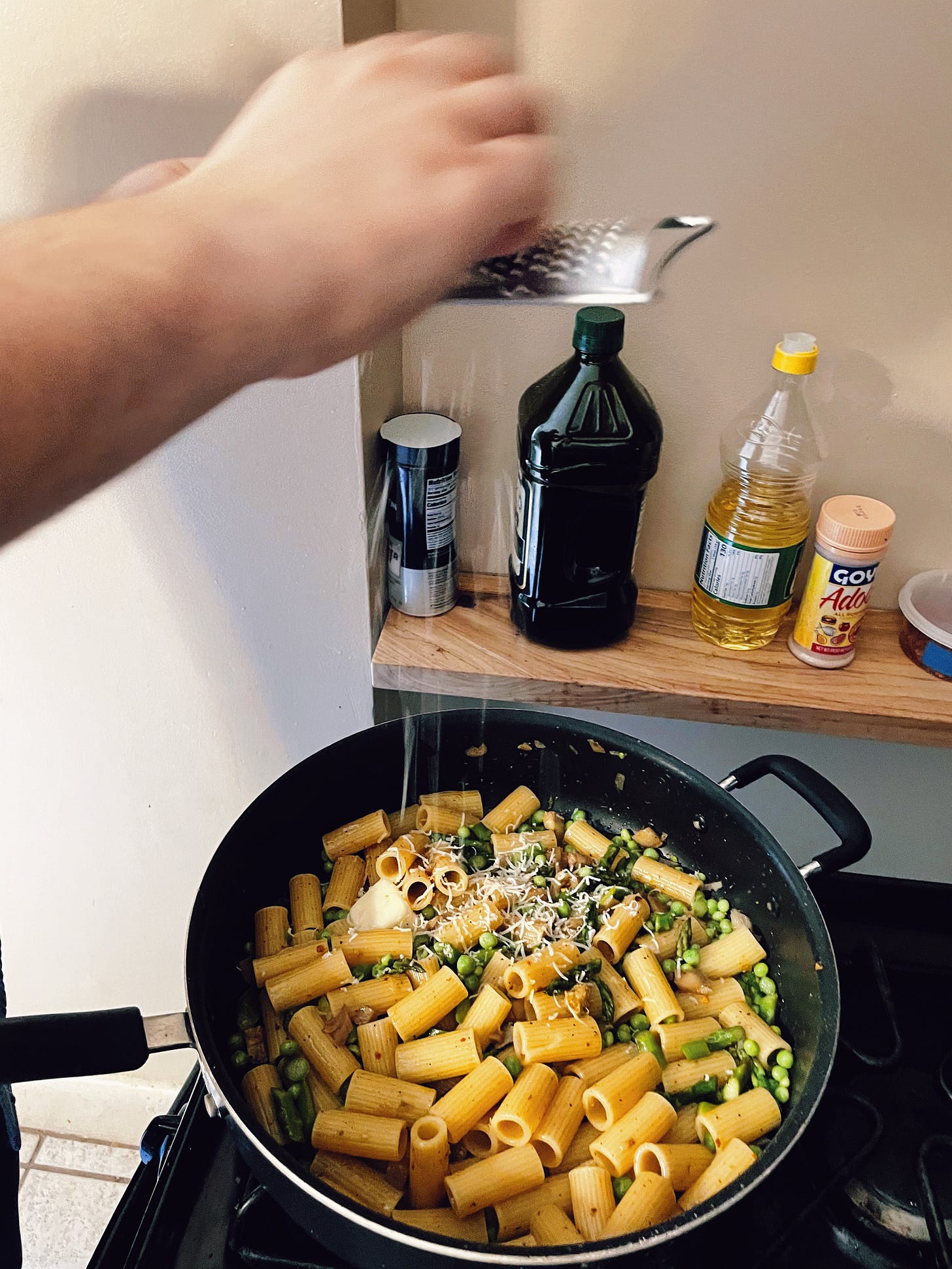
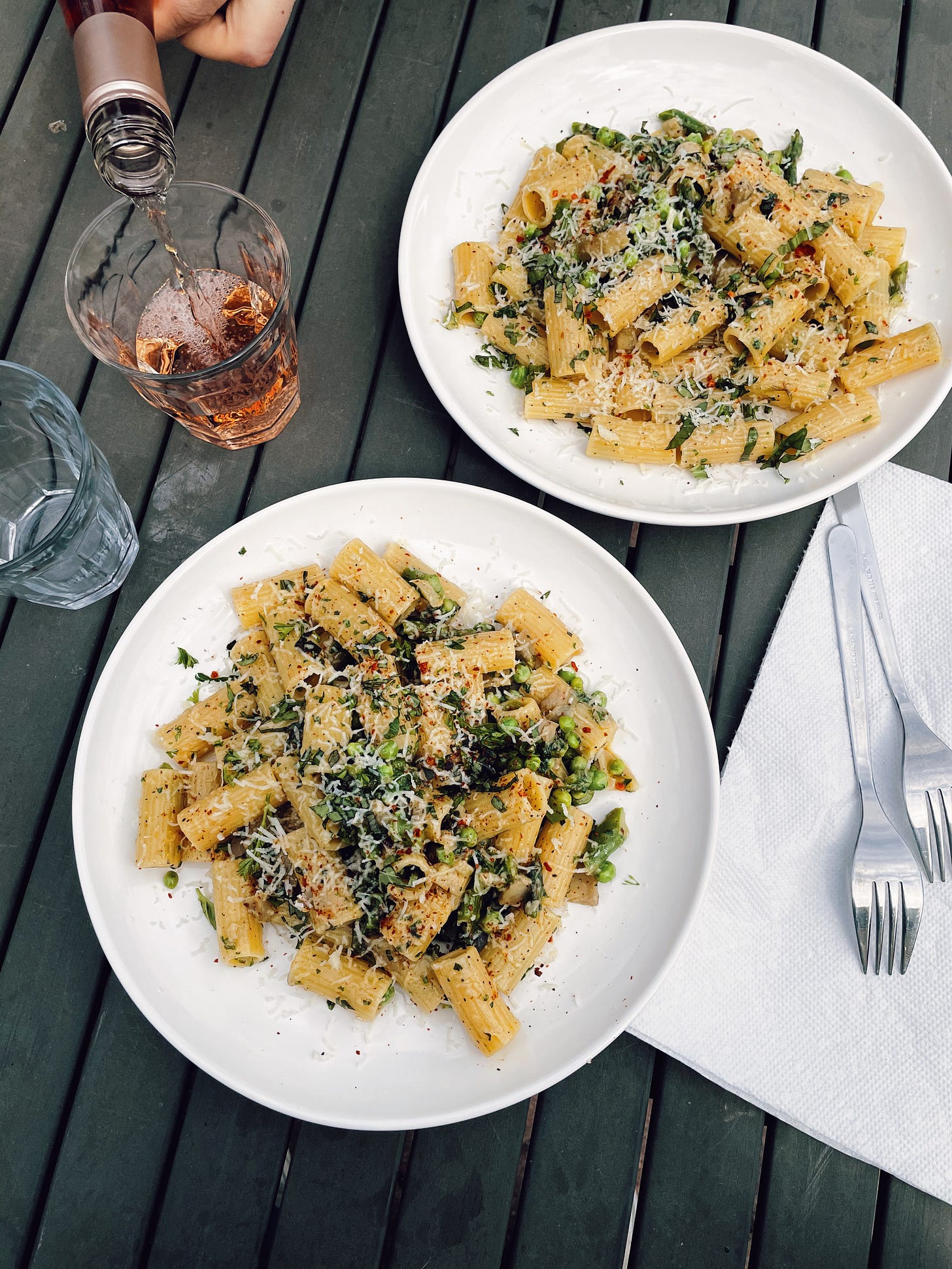
Love this passage: “As I delivered this information to him in the urgent tones of someone who hasn’t seen another human being all day, I felt myself entering the ominous psychological state of Betty Draper, or, hell, Betty Friedan, with my single-minded intensity and almost-loathing for our home, my birdcage.”